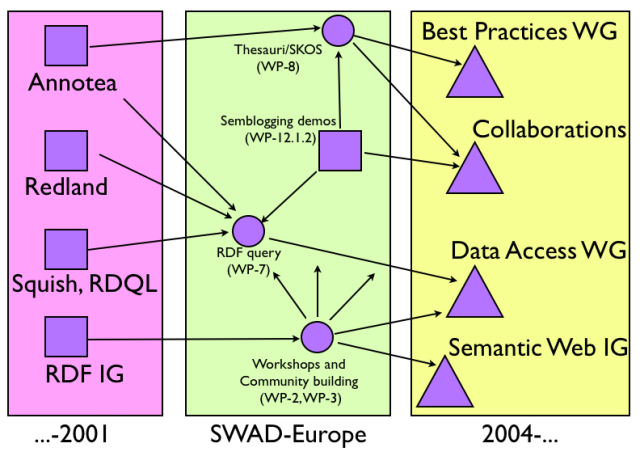SWAD-Europe originated within W3C's Semantic Web Activity, extending the approach taken in previous SWAD work at MIT to focus on collaborative work undertaken alongside the World Wide Web Consortium's RDF (now Semantic Web) Interest Group. While the project is about and in support of W3C's Semantic Web Activity, it is managed independently. The project was created to complement and feed into 'standards track' work within the World Wide Web Consortium (W3C). SWAD-Europe is a collaboration between the World Wide Web Consortium in Europe, hosted by ERCIM, research institutions at the Central Laboratory of the Research Councils (CLRC) and the University of Bristol (ILRT), and the companies Stilo International Plc and Hewlett-Packard Ltd.
SWAD-Europe was designed to support W3C's Semantic Web initiative in Europe, providing targeted research, demonstrations and outreach. The aim was to support the development and deployment of W3C Semantic Web specifications through implementation, research and testing activities. This involved finding and maintaining a balance between "in-house" Open Source tool development, community building, outreach and evangelism, combined with research and analysis to support and field-test Semantic Web standards. In practice, this meant that more time was spent working with members of the Semantic Web Interest Group community than on in-house development work, since this approach helped establish a broader base for Semantic Web development than could be accomplished within a single European project. The Interest Group provided a forum that connected SWAD-Europe (and other SemWeb-themed projects, from Europe and elsewhere) to the more formal standardisation activities of the W3C.
SWAD-Europe's work is best understood in the context of the challenges facing the RDF project in the 1997-2001 period prior to the creation of the Semantic Web Activity at W3C. In RDF's early years, a number of difficulties needed addressing. At that time, RDF technology was perceived by some as complex and overambitious, with poorly formalised specifications. Software tools were relatively immature, with toolkit-specific APIs and query languages, which meant that application code was often tightly bound to a specific RDF toolkit. The relationship between RDF and XML in terms of both tools and standards was unclear. Despite the difficulties faced by RDF in this period, there was nevertheless a lot of enthusiasm from early adopters of RDF which emerged in the Interest Group. The design of the project was an attempt to find a way to use the structure of a European project to support both formal standardisation work at W3C, and the community fora (Interest Groups) which can provide a home for users of Web technology to share their experiences.
The project's initial workplan included work on reviewing and developing tools to access, store, search Semantic Web data, with the goal of motivating and informing future work on RDF query languages and APIs. Practical case studies and demos were proposed, especially in "near term" areas such as thesaurus systems and next-generation blogging tools. A fair number of workshops were included, to foster developer discussion on critical "seed applications", e.g. image annotation, calendaring, social networking and geo/mapping work. In addition to these efforts, the project tried to emphasise the importance not only of standards-based technology, but on technology integration. We undertook work on linking XML to RDF, on schema languages, SVG, query, XForms and Web Services. In each case, there was the same underlying intent: to enter into dialogue with users of W3C technology and understand how their practical problems might be addressed through combing RDF approaches with other, perhaps better understood, standards-based methods. The goal, in effect, was to help demonstrate the basics of Semantic Web as a fast-maturing technology platform. Reports from each of these activity areas are available from the project Web site [RESULTS].
Throughout SWAD-Europe, we sought to build on pre-existing work, in particular work which was conducted in public fora and was supported by freely available opensource implementations. The diagram in [fig.1] shows a few example work items, emphasising the way in which previous collaborative efforts (by the project partners and members of the broader community) were supported through SWAD-Europe and subsequently fed into more formal activities within W3C. This illustrates the project's general approach, which is to utilize W3C's Interest Group mechanism to bring collaborators together, test their ideas, and present the results of those collaborations in a form that can have a good prospect of adoption within the Working Group mechanisms of W3C.
[fig.1. - example workflow]
